In aquariums, some fish prefer living in the upper of the tank, while some are fond of swimming in the middle. Also, others take a fancy to the bottom of the tank. In today’s article, we will walk you through something about the bottom feeder fish for freshwater community tanks.
Content Table
Bottom Feeder Meaning
Here comes a question, what are bottom feeders? If you know little about them, just continue reading. Bottom feeders are those animals living or feeding on or near the bottom of the water. Concerning the bottom feeders in aquariums, some help removes algae and clean the aquarium, like Otocinclus catfish, snails, and shrimp.
Besides, as for the bottom feeder fish in aquariums, you can recognize them by observing the mouth placement (usually a lower mouth placement), barbels near the mouth (sensory organs to identify food), and mouth shape (some fish have mouth shaping like suction). Furthermore, aquarium bottom-feeder fish are commonly classified into three categories – Loaches, Catfish, and Carp. Loaches fancy building homes on the substrate in the aquarium. Catfish feature obvious barbels. Carps possess soft fins, like the Prussian carp.
Top 10 Bottom Feeder Fish
In this segment, we will share ten bottom-feeder fish that are most popular in aquariums. After reading, you can choose your favorite one for tanks.
1. Kuhli Loach
Featuring a long body with strips, Kuhli Loaches likes to hide. They usually burrow under the aquarium substrate. Thus, you should choose sand or fine gravel as the substrate for Kuhli Loach aquariums. Moreover, it is better to keep the schooling of Kuhli Loaches in a tank. Aggressive tank mates should be avoided, like cichlids. Additionally, Kuhli Loaches are active at night. So, you can keep a light on at that time.
| Origin | Southeast Asia | Swimming level | Bottom |
| Adult size | 3– 5 inches | Diet | Omnivore |
| Lifespan | 10 years | Ideal water temperature | 75–86℉ |
| Temperament | Peaceful | Ideal pH level | 5.5–6.5 |
| Care Level | Easy–Moderate | Minimum tank size | 20 gallons |
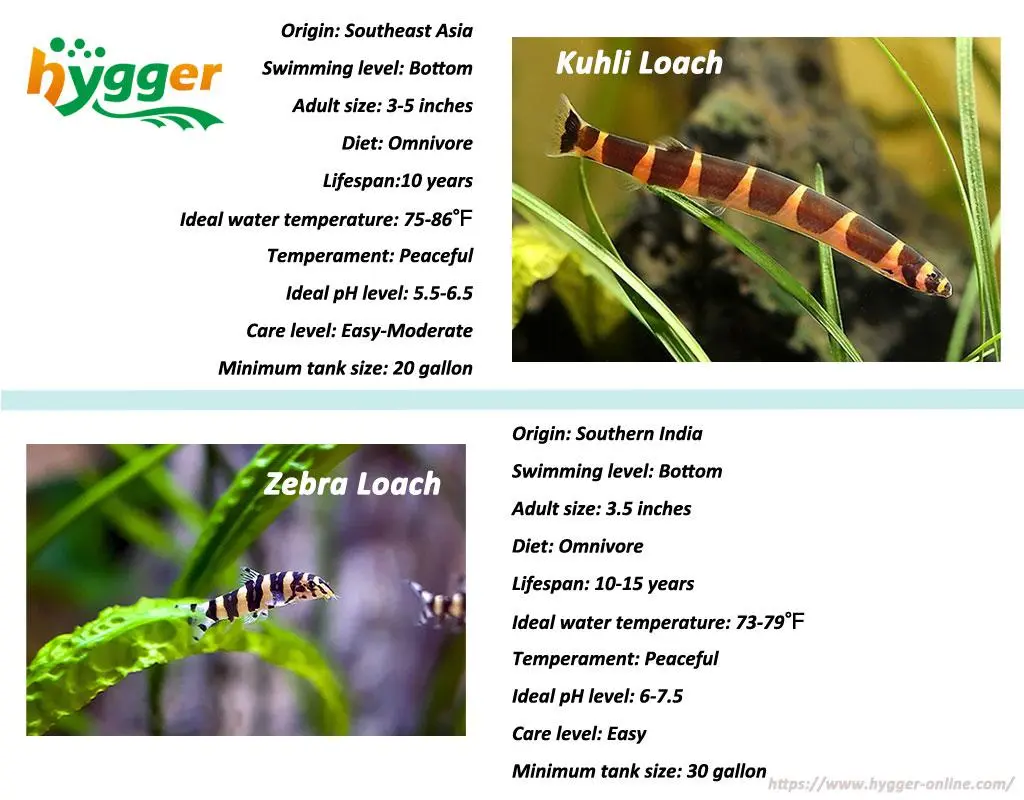
2. Zebra Loach
Zebra Loaches come with strips on the body, which are different in color and thickness. They are hardy and can adapt to changes in water conditions. In general, you can hold the Zebra Loaches with other Loaches. However, Zebra Loaches are not good tank mates for fish with long tails and fins, like Angelfish. Because Zebra Loaches may nip their tails and fins. Aside from that, Zebra Loaches need adequate hiding places, great water conditions, and dim light. And contrary to the Kuhli Loaches, Zebra Loaches are not nocturnal.
| Origin | Southern India | Swimming level | Bottom |
| Adult size | 3.5 inches | Diet | Omnivore |
| Lifespan | 10–15 years | Ideal water temperature | 73–79℉ |
| Temperament | Peaceful | Ideal pH level | 6–7.5 |
| Care Level | Easy | Minimum tank size | 30 gallons |
3. Yoyo Loach
Yoyo Loaches are peaceful and can get along well with other Loaches. Nevertheless, never keep them with extremely aggressive or timid fish. Otherwise, it may cause injury. Most Loaches are fond of digging under the tank substrate, the same goes for Yoyo Loaches. On the other side, Yoyo Loaches are demanding water conditions. Hence, monitoring the water conditions regularly would be necessary. Also, Yoyo Loaches are active and may jump out of the tank. Consequently, it is recommended to add an aquarium lid.
| Origin | North and Northeast India | Swimming level | Bottom-Middle |
| Adult size | 2.5–3 inches | Diet | Omnivore |
| Lifespan | 5–8 years | Ideal water temperature | 75–82℉ |
| Temperament | Peaceful | Ideal pH level | 6.5–7.5 |
| Care Level | Moderate | Minimum tank size | 20 gallons |
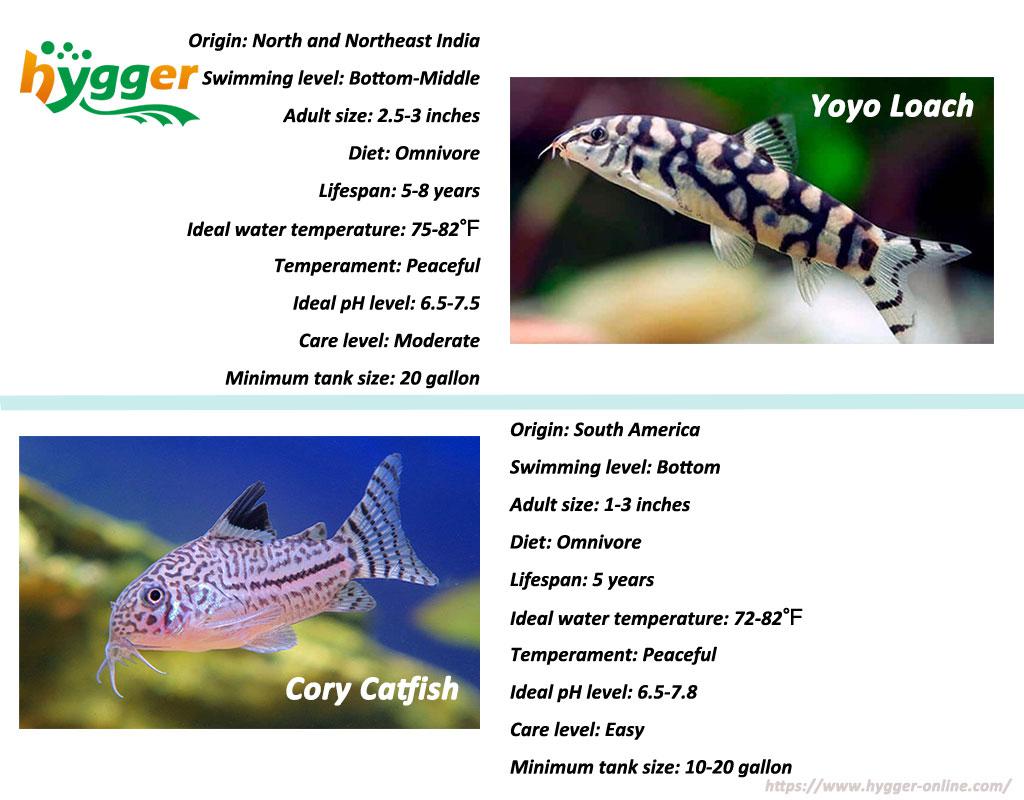
4. Cory Catfish
Cory Catfish feature barbels extending from the face. And there are diverse colors and sizes of Cory Catfish. Also, they come in different types, for example, Albino Cory Catfish, Panda Cory Catfish, and Pygmy Cory Catfish. Besides that, they enjoy hiding behind plants or rocks in the wild. Therefore, it is best to add aquatic plants in the Cory Catfish aquarium, such as Java Moss, Java Fern, and Hornwort. It will provide an enjoyable living environment for them.
| Origin | South America | Swimming level | Bottom |
| Adult size | 1–3 inches | Diet | Omnivore |
| Lifespan | 5 years | Ideal water temperature | 72–82℉ |
| Temperament | Peaceful | Ideal pH level | 6.5–7.8 |
| Care Level | Easy | Minimum tank size | 10–20 gallon |
5. Otocinclus Catfish
Otocinclus Catfish are also famous as Oto, which are schooling fish and like living in groups. Aside from that, they can eat algae quickly and need a lot of algae to survive. However, they are small and peaceful. Hence, you should not keep them with large cichlids. Otherwise, it would cause injury.
| Origin | South America | Swimming level | Bottom |
| Adult size | 2 inches | Diet | Herbivore |
| Lifespan | 5–7 years | Ideal water temperature | 72–82℉ |
| Temperament | Peaceful | Ideal pH level | 6.5–7.0 |
| Care Level | Easy–Moderate | Minimum tank size | 10 gallons |
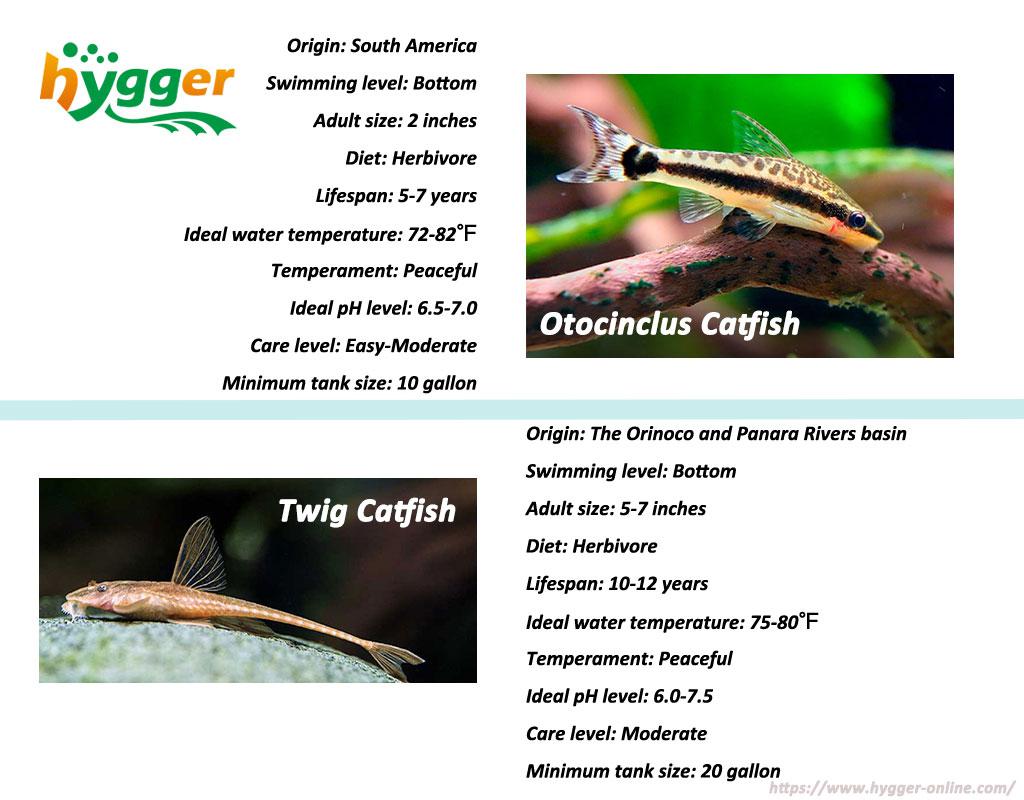
6. Twig Catfish
The Twig Catfish are long and thin. Unlike other active fish, Twig Catfish usually stay or attach to the object’s surface. And they may not a good choice for small fish tanks, where toxic substances may accumulate easily. Since Twig, Catfish require clean water to survive.
| Origin | The Orinoco and Panara Rivers basin | Swimming level | Bottom |
| Adult size | 5–7 inches | Diet | Herbivore |
| Lifespan | 10–12 years | Ideal water temperature | 75–80℉ |
| Temperament | Peaceful | Ideal pH level | 6.0–7.5 |
| Care Level | Moderate | Minimum tank size | 20 gallons |
7. Synodontis Catfish
The patterns and spots on the body make Synodontis Catfish attractive. They can be an excellent addition to African cichlid tanks. Also, they may show interesting behaviors. For instance, swimming upside down.
| Origin | Eastern Africa | Swimming level | Bottom |
| Adult size | 4 inches | Diet | Omnivore |
| Lifespan | 8–10 years | Ideal water temperature | 75–82℉ |
| Temperament | Peaceful | Ideal pH level | 6.5–8.5 |
| Care Level | Easy | Minimum tank size | 20 gallons |
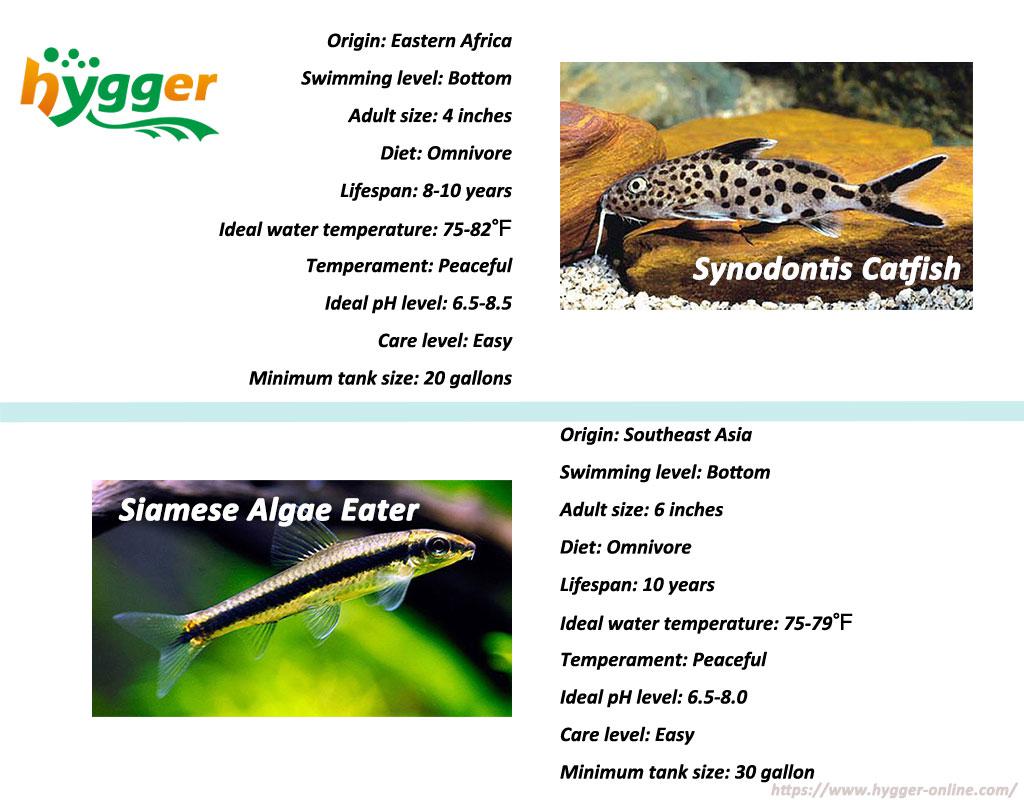
8. Siamese Algae Eater
Siamese Algae Eaters are called the king of algae eater fish. Black beard algae, hair algae, and uneaten food are food sources for Siamese Algae Eaters. They require sufficient oxygen and plenty of room to move around the tank. Accordingly, a large tank is perfect to hold them. Nonetheless, they may attack small fish occasionally. So, just be careful to avoid small tank mates.
| Origin | Southeast Asia | Swimming level | Bottom |
| Adult size | 6 inches | Diet | Omnivore |
| Lifespan | 10 years | Ideal water temperature | 75–79℉ |
| Temperament | Peaceful | Ideal pH level | 6.5–8.0 |
| Care Level | Easy | Minimum tank size | 30 gallons |
9. Bristlenose Pleco
Bristlenose Plecos have protruding bristles on the mouth and nose. Sometimes, their brown body color makes them invisible in tanks. Also, they are not aggressive. Consequently, they can keep peace with other fish in aquariums. Moreover, Bristlenose Plecos are beneficial to clean aquariums and maintaining ideal living conditions. Because they eat algae, decaying plants, fish feces, fish uneaten food, and other waste. In addition, the sucker-shaped mouth can clean the aquarium glass by adsorbing on the glass.
| Origin | South America | Swimming level | Bottom |
| Adult size | 4–5 inches | Diet | Omnivore |
| Lifespan | 5 years | Ideal water temperature | 70–80℉ |
| Temperament | Peaceful | Ideal pH level | 6.5–7.5 |
| Care Level | Easy-Moderate | Minimum tank size | 30 gallons |
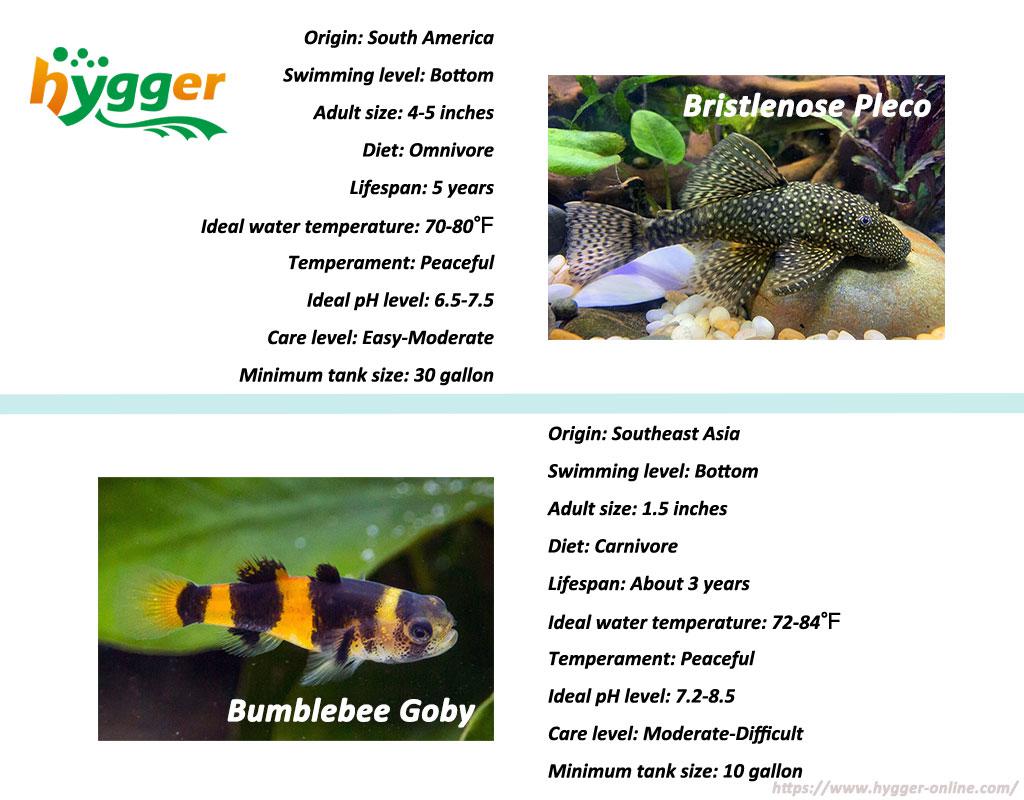
10. Bumblebee Goby
Bumblebee Gobies are small and have strips on their body, which look like bees in the water. They are active and usually swim around the aquarium. Also, they prefer living in a group of six at least. Additionally, they can thrive in brackish water.
| Origin | Southeast Asia | Swimming level | Bottom |
| Adult size | 1.5 inches | Diet | Carnivore |
| Lifespan | About 3 years | Ideal water temperature | 72–84℉ |
| Temperament | Peaceful | Ideal pH level | 7.2–8.5 |
| Care Level | Moderate-Difficult | Minimum tank size | 10 gallons |
What Bottom Feeders Are Good For a 5-gallon Fish Tank
In addition to all the bottom feeders mentioned above, are there bottom feeders for a 5-gallon fish tank? Seeing that 5 gallons is a relatively small aquarium, you should be cautious about the quantities of tank mates. Otherwise, it may cause overstocking. When it comes to the bottom feeders for a 5-gallon fish tank, Stone Catfish, snails (e.g. Apple Snails, Mystery Snails, Nerite Snails), and shrimp (e.g. Ghost Shrimp, Red Cherry Shrimp, Amano Shrimp) are excellent alternatives. For instance, if you have a betta fish tank, it is feasible to keep one betta plus two or three ghost shrimp in the tank.
The Bottom Line
After reading, do you know more about the bottom feeder fish? Some of the bottom feeders are excellent cleaner fish, like Otocinclus Catfish and Siamese Algae Eaters. By the way, if you are interested in other aquatic pet fish, or cleaner fish, you can learn more from the article – Cleaner Fish Profiles – Best Cleaner Fish for Freshwater. That’s all for today. Finally, thanks for your time, and we hope this article helps.

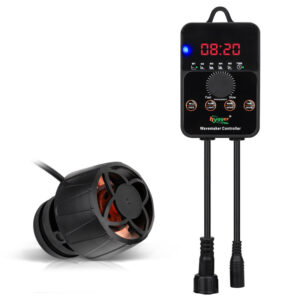
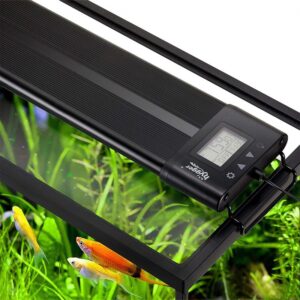
Leave a comment